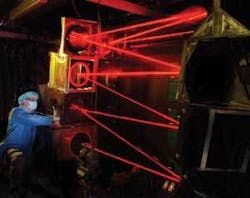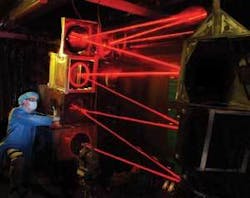By John Keller
KIRTLAND AFB, N.M. - U.S. Air Force researchers are asking the defense industry for ideas for a new electro-optics research program called Light Innovation Technologies-otherwise known as LITE.
The program consists of five areas involving surveillance, adaptive optics, multispectral data processing, and advanced beam control. Conducting the research are experts at the Air Force Research Laboratory Directed-Energy Directorate at Kirtland Air Force Base, N.M.
Companies that would like to participate in these LITE research programs have just a short time to submit their ideas. Proposals from interested companies are due by noon mountain time on March 27.
The first topic area of the LITE program is called Real-time Optical Surveillance Applications (ROSA). Technical solutions should involve algorithms and software tools that will process significant amounts of real-time electro-optic space-situational-awareness (SSA) data and produce real-time, accurate change-detection information in very low-light conditions, as well as software to integrate tasking and data integration from networks of electro-optic sensors with disparate capabilities.
Technologies developed will include intelligent agent autonomous algorithms, databasing, novel search techniques, and real-time processing software for anomaly detection and cueing of active (laser) and passive electro-optic systems.
Estimated funding for this segment is $10 million. The technical point-of-contact for this segment is Laura Ulibarri, whose phone number is 808-891-7737.
The second area of interest is called Adaptive Optics Improvements, in which the Air Force Research Laboratories Optics Division would like to improve the reliability, maintainability, and performance of its existing adaptive-optics systems for advanced research and development enabled by adaptive-optics technology.
This job involves improving the adaptive-optics tracker and wavefront- sensor subsystem for the Air Force Maui Optical and Supercomputing (AMOS) Site’s 3.6-meter telescope. The Air Force wants solutions that provide high reliability, easy maintenance, and high performance for high-resolution imaging and sodium laser-guidestar (Na LGS) beacon for dim objects.
This job also will develop an improved electronic subsystem for the AMOS site’s 3.6-meter telescope and starfire optical range’s 3.5-meter telescope. It should be a flexible adaptive-optics electronics subsystem able to interface with several adaptive optics tracker and wavefront sensor subsystems
Applications for this processor will require good latency supporting a large number of channels, and the processor should be flexible enough to accommodate additional channels to allow for expansion
Estimated funding for this segment is $3.3 million. The technical point of contact is Lt. Col. Scott Hunt, whose phone number is 808-874-1513, and Earl Spillar, whose phone number is 505-846-6740.
The third area of interest in the LITE program is called Advanced Research Adaptive Optics Prototype, which will develop a research-grade adaptive-optics electronics control prototype for advanced adaptive-optics research.
Flexibility in the design should allow for testing of sophisticated reconstructors, sensors, and deformable mirror configurations. For example, these sensors may include self-referencing interferometers, shearing interferometers, or other advanced concepts.
The prototype should be able to accommodate a large number of actuators and sensed subapertures, possibly distributed across several deformable mirrors. Ability to develop, test, and accommodate advanced reconstruction techniques for self referencing interferometers, exponential reconstructors, and other advanced concepts is necessary.
Estimated funding for this portion is $500,000. The technical point of contact is Earl Spillar, whose phone number is 505-846-6740.
The fourth area of interest is called Hyper/multispectral Data Reduction and Archiving (HyDRA), which calls for spectral geographic information system database solutions to enhance target acquisition and fire control for tactical high-energy laser systems, such as relay systems.
This task will provide pre- and post-flight and real-time software advancements in target identification and change/anomaly detection for multispectral and hyperspectral surveillance and targeting sensors.
Estimated funding is $10 million. The technical point of contact is Bob Kim, whose phone number is 505 853-7806.
Finally, the fifth area of interest is called Advanced Architecture Concept Study for Advanced Beam Control, which is to conceptualize innovative beam control architectures for conventional (single beam) systems such as advanced pointing and tracking systems.
These new concepts can apply to alignment jitter rejection, adaptive optics, gimbal pointing, tracking, pointing, or a combination of control functions. An inertial reference shall be included if applicable. Size and weight will be a major consideration. Considerations for base motion and aero-optics are important.
Estimated funding is $300,000. The technical point of contact is Paul Merritt, whose phone number is 505-853-5477.
The primary contracting point of contact for the LITE research program is Rhoda Parker. Contact her at Det 8 AFRL/PKDB (Directorate of Contracting), 2251 Maxwell Ave. SE, Kirtland AFB, N.M. 87117-5773, by phone at 505-853-7282, by fax at 505-846-1546, or by e-mail at [email protected].
The Contracting Officer is Barbara Steinbock. Contact her at Det 8 AFRL/PKDB (Directorate of Contracting, 2251 Maxwell Ave. SE, Kirtland AFB, N.M. 87117-5778, by phone at 505-846-2246, or by e-mail at [email protected].
More information about this project is online at www.fbodaily.com/archive/2007/02-February/11-Feb-2007/FBO-01229406.htm.




